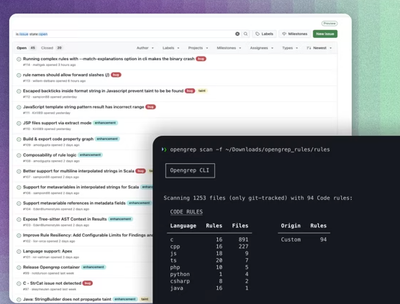
Research
Security News
Lazarus Strikes npm Again with New Wave of Malicious Packages
The Socket Research Team has discovered six new malicious npm packages linked to North Korea’s Lazarus Group, designed to steal credentials and deploy backdoors.
@polymer/neon-animation
Advanced tools
neon-animation is a suite of elements and behaviors to implement pluggable animated transitions for Polymer Elements using Web Animations.
Warning: The API may change.
Elements that can be animated should implement the Polymer.NeonAnimatableBehavior behavior, or Polymer.NeonAnimationRunnerBehavior if they're also responsible for running an animation.
Polymer({
is: 'my-animatable',
behaviors: [
Polymer.NeonAnimationRunnerBehavior
],
properties: {
animationConfig: {
value: function() {
return {
// provided by neon-animation/animations/scale-down-animation.html
name: 'scale-down-animation',
node: this
}
}
}
},
listeners: {
// this event is fired when the animation finishes
'neon-animation-finish': '_onNeonAnimationFinish'
},
animate: function() {
// run scale-down-animation
this.playAnimation();
},
_onNeonAnimationFinish: function() {
console.log('animation done!');
}
});
An element might run different animations, for example it might do something different when it enters the view and when it exits from view. You can set the animationConfig property to a map from an animation type to configuration.
Polymer({
is: 'my-dialog',
behaviors: [
Polymer.NeonAnimationRunnerBehavior
],
properties: {
opened: {
type: Boolean
},
animationConfig: {
value: function() {
return {
'entry': {
// provided by neon-animation/animations/scale-up-animation.html
name: 'scale-up-animation',
node: this
},
'exit': {
// provided by neon-animation/animations/fade-out-animation.html
name: 'fade-out-animation',
node: this
}
}
}
}
},
listeners: {
'neon-animation-finish': '_onNeonAnimationFinish'
},
show: function() {
this.opened = true;
this.style.display = 'inline-block';
// run scale-up-animation
this.playAnimation('entry');
},
hide: function() {
this.opened = false;
// run fade-out-animation
this.playAnimation('exit');
},
_onNeonAnimationFinish: function() {
if (!this.opened) {
this.style.display = 'none';
}
}
});
You can also use the convenience properties entryAnimation and exitAnimation to set entry and exit animations:
properties: {
entryAnimation: {
value: 'scale-up-animation'
},
exitAnimation: {
value: 'fade-out-animation'
}
}
You can pass additional parameters to configure an animation in the animation configuration object. All animations should accept the following properties:
name: The name of an animation, ie. an element implementing Polymer.NeonAnimationBehavior.node: The target node to apply the animation to. Defaults to this.timing: Timing properties to use in this animation. They match the Web Animations Animation Effect Timing interface. The
properties include the following:
duration: The duration of the animation in milliseconds.delay: The delay before the start of the animation in milliseconds.easing: A timing function for the animation. Matches the CSS timing function values.Animations may define additional configuration properties and they are listed in their documentation.
Set the animation configuration to an array to combine animations, like this:
animationConfig: {
value: function() {
return {
// fade-in-animation is run with a 50ms delay from slide-down-animation
'entry': [{
name: 'slide-down-animation',
node: this
}, {
name: 'fade-in-animation',
node: this,
timing: {delay: 50}
}]
}
}
}
You can include animations in the configuration that are encapsulated in a child element that implement Polymer.NeonAnimatableBehavior with the animatable property.
animationConfig: {
value: function() {
return {
// run fade-in-animation on this, and the entry animation on this.$.myAnimatable
'entry': [
{name: 'fade-in-animation', node: this},
{animatable: this.$.myAnimatable, type: 'entry'}
]
}
}
}
The artist formerly known as <core-animated-pages>
The neon-animated-pages element manages a set of pages to switch between, and runs animations between the page transitions. It implements the Polymer.IronSelectableBehavior behavior. Each child node should implement Polymer.NeonAnimatableBehavior and define the entry and exit animations. During a page transition, the entry animation is run on the new page and the exit animation is run on the old page.
Shared element animations work on multiple nodes. For example, a "hero" animation is used during a page transition to make two elements from separate pages appear to animate as a single element. Shared element animation configurations have an id property that identify they belong in the same animation. Elements containing shared elements also have a sharedElements property defines a map from id to element, the element involved with the animation.
In the incoming page:
properties: {
animationConfig: {
value: function() {
return {
// the incoming page defines the 'entry' animation
'entry': {
name: 'hero-animation',
id: 'hero',
toPage: this
}
}
}
},
sharedElements: {
value: function() {
return {
'hero': this.$.hero
}
}
}
}
In the outgoing page:
properties: {
animationConfig: {
value: function() {
return {
// the outgoing page defines the 'exit' animation
'exit': {
name: 'hero-animation',
id: 'hero',
fromPage: this
}
}
}
},
sharedElements: {
value: function() {
return {
'hero': this.$.otherHero
}
}
}
}
For convenience, if you define the entry-animation and exit-animation attributes on <neon-animated-pages>, those animations will apply for all page transitions.
For example:
<neon-animated-pages id="pages" class="flex" selected="[[selected]]" entry-animation="slide-from-right-animation" exit-animation="slide-left-animation">
<neon-animatable>1</neon-animatable>
<neon-animatable>2</neon-animatable>
<neon-animatable>3</neon-animatable>
<neon-animatable>4</neon-animatable>
<neon-animatable>5</neon-animatable>
</neon-animated-pages>
The new page will slide in from the right, and the old page slide away to the left.
Single element animations:
fade-in-animation Animates opacity from 0 to 1;fade-out-animation Animates opacity from 1 to 0;scale-down-animation Animates transform from scale(1) to scale(0);scale-up-animation Animates transform from scale(0) to scale(1);slide-down-animation Animates transform from translateY(-100%) to none;slide-up-animation Animates transform from none to translateY(-100%);slide-from-top-animation Animates transform from translateY(-100%) to none;slide-from-bottom-animation Animates transform from translateY(100%) to none;slide-left-animation Animates transform from none to translateX(-100%);slide-right-animation Animates transform from none to translateX(100%);slide-from-left-animation Animates transform from translateX(-100%) to none;slide-from-right-animation Animates transform from translateX(100%) to none;transform-animation Animates a custom transform.Note that there is a restriction that only one transform animation can be applied on the same element at a time. Use the custom transform-animation to combine transform properties.
Shared element animations
hero-animation Animates an element such that it looks like it scales and transforms from another element.ripple-animation Animates an element to full screen such that it looks like it ripples from another element.Group animations
cascaded-animation Applys an animation to an array of elements with a delay between each.FAQs
A system for animating Polymer-based web components
The npm package @polymer/neon-animation receives a total of 14,494 weekly downloads. As such, @polymer/neon-animation popularity was classified as popular.
We found that @polymer/neon-animation demonstrated a not healthy version release cadence and project activity because the last version was released a year ago. It has 11 open source maintainers collaborating on the project.
Did you know?

Socket for GitHub automatically highlights issues in each pull request and monitors the health of all your open source dependencies. Discover the contents of your packages and block harmful activity before you install or update your dependencies.

Research
Security News
The Socket Research Team has discovered six new malicious npm packages linked to North Korea’s Lazarus Group, designed to steal credentials and deploy backdoors.

Security News
Socket CEO Feross Aboukhadijeh discusses the open web, open source security, and how Socket tackles software supply chain attacks on The Pair Program podcast.

Security News
Opengrep continues building momentum with the alpha release of its Playground tool, demonstrating the project's rapid evolution just two months after its initial launch.